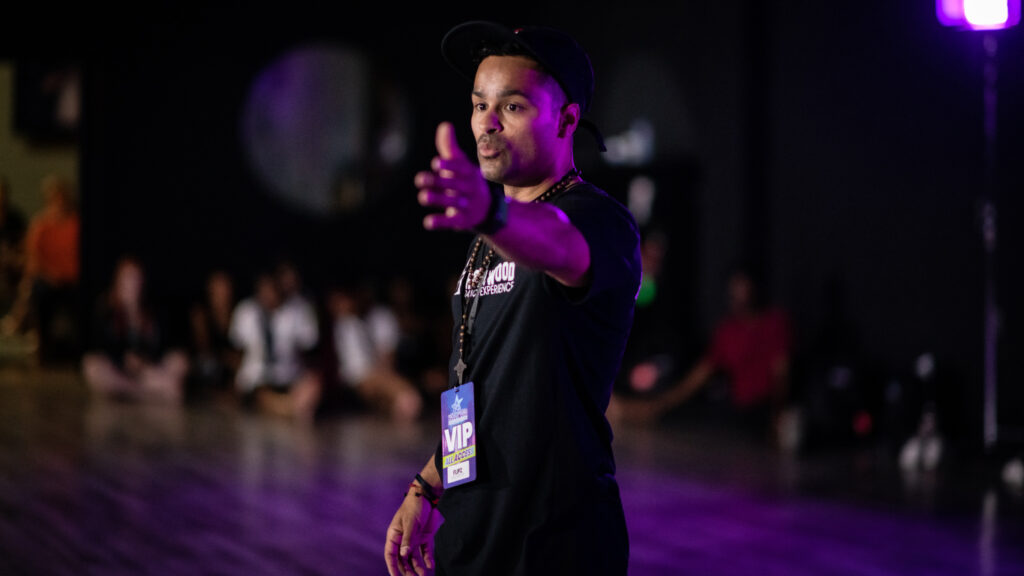This summer, dance fans will be on the edge of their seats awaiting the debut of the newest Olympic sport: breaking. But when the style takes the Olympic stage, how will the competition unfold, and what should viewers be looking for? Understanding the intricacies of the judging system—and how it’s been adjusted to work in the Olympics, while still honoring breaking’s history—offers a window into how an art form will be incorporated into one of the most-watched sporting events worldwide.
Structure and Scoring
Olympic breaking will be split into two events, one for b-boys and one for b-girls. There will be 32 competitors, with equal gender representation, from between eight and 16 countries (qualification events were still happening at press time).

Within the gendered events, dancers start in a round-robin schedule, in which they compete in one-on-one battles, explains Zack “Cracker Zacks” Slusser, vice president of DanceSport Breaking. The 16 athletes will be split into four groups of four, with each dancer going head-to-head in solo battles with each of the other three dancers in their group for two rounds, resulting in a total of six rounds.
 Zack “Cracker Zacks” Slusser. Photo by Nito Rihal.
Zack “Cracker Zacks” Slusser. Photo by Nito Rihal.
 Photo by Tyquan Hodac, Courtesy Slusser.
Photo by Tyquan Hodac, Courtesy Slusser.
The top eight dancers (two from each group of four) advance to the “knockout” stage. In this stage, dancers are seeded into brackets, and each bracket matchup has three rounds. Bracket winners progress from quarterfinals to semifinals to finals, with the winner being awarded Olympic gold.
Judges score dancers based on five criteria: execution, technique, originality, musicality, and vocabulary. Hearkening back to hip hop’s roots, scores will be represented comparatively by a DJ fader. In each head-to-head battle, judges will move each of the five digital sliders (either a little or all the way) toward the breaker who is stronger in each category. Viewers will only see who each judge ultimately votes for, indicated by a blue or a red box displayed on a large LED scoreboard.
What to Watch For
With rapid-fire rounds and incredible talent, there will be plenty to see during breaking’s Olympic debut. Ivan “Flipz” Velez, a veteran breaker and a member of the judging panel in Paris, recommends watching for the fundamentals of the form, like “smoothness, creative transitions, and levels.” Velez also advises looking out for power moves and noticing how many moves dancers can combine and stack. “The longer the combo, the cooler the moves, the higher you score,” he says. Dancers will be responding to the tracks that the deejay decides to spin.
 Photo by Adrian Ruiz/Hollywood Dance Experience, Courtesy Velez.
Photo by Adrian Ruiz/Hollywood Dance Experience, Courtesy Velez.
In addition to these showstopping movements, the intricacy of each dancer’s craft is also important, notes veteran breaker Gabriel “Kwikstep” Dionisio. The way a dancer executes a step or phrase can give hints into their background, origins, training, and personality. “How you ride the rhythm, how you express your particular style and individuality through the music and the dance—it also exposes your social background,” he says.
Acknowledging Breaking’s History
The bright international spotlight of the Olympics will illuminate not only the athleticism of breaking but also its artistry, history, and legacy. Veteran breaker Ana “Rokafella” Garcia hopes viewers will learn about the social roots of the form, and be aware of the fact that breakers often learn in nontraditional spaces, sometimes among friends and without a traditional coach or teacher. She emphasizes that hip hop is a genre in flux from generation to generation. “It definitely allows for interpretation and contributions from each dancer and each generation,” she explains.
Dionisio also hopes that breaking’s geographic and cultural roots will be acknowledged, explaining that the genre was born in New York City, among communities of color during a time of great upheaval. “That’s what hip hop is—it’s a diamond that was born under the pressures of economic woes and cultural wars of the time,” Dionisio says. “To come out shining from those times with something called hip hop, and to present that diamond to the world, is exactly what needs to be done at the Olympics.”




GIPHY App Key not set. Please check settings